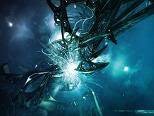When he wasn't selling any color model T, as long as it was black, Henry Ford, with the grace of Tacitus and the air of Caesar (Sid, not Julius), amused his clientele with the observation that "History is bunk." "Bunk" meaning traditional and not worth a "tinker's damn" to the present day. Ford's aversion for the past may have been due to the sheer volume of names, dates, events and customs verging on a deluge of confused and dubious data. Unfortunately, Battle of the Smithsonian has the ill luck to be swept up in the tide. While not being completely and utterly "bunk," the film suffers from having one too many museums, leading to a thousand too many cast members, who might be called extras if everyone weren't supposed to be someone famous. In addition to the original cast, audiences must process the Thinker, the Ballerina, Aphrodite, the Tuskegee Airman, the Wright Brothers, Abraham Lincoln, American Gothic, three Cupids, six Einsteins, and - (insert deep breath here) - a full-blown NASA launch crew.
The initial "Oh my God!" reaction (which surfaces upon seeing Hank Azaria in a tunic with a lisp) loses all enthusiasm after a perky introduction to Amy Adams, whose gutsy performance as Amelia Earhart is the true high-light of this quirky, but teeming film. The rest of the characters, with the exception of the central supporting cast, come off as little more than a confused mob of tricorns, ushankas and three-pieced suits. Slapstick comedy (a hallmark of any Stiller film) has its fine points with funny man Jonah Hill and Simpson's favorite, Hank Azaria, playing Abbot to Stiller's passive-agressive Costello, but quickly becomes overbearing, verging on corny. On the money, Battle of the Smithsonian is a charming and entertaining family flick, but one that is sure to go down in history as a side-show act for a number of high-profile actors in period garb.

